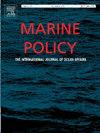Undersea cables, geoeconomics, and security in the Indo-Pacific: Risks and resilience
IF 3.7
2区 社会学
Q2 ENVIRONMENTAL STUDIES
引用次数: 0
Abstract
Undersea cables constitute the critical infrastructure of international data connectivity, transmitting over 95 % of global Internet traffic, and they have attracted increasing attention from policymakers recently. How are threats to undersea cable networks evolving, and why is cable competition intensifying in the Indo-Pacific region? How is the policy discourse around undersea cables changing, and what implications does this have for the physical realities of these networks and their resilience? This article introduces a framework for understanding recent developments and presents an analysis of cross-regional trends, providing the foundation for a Special Issue of Marine Policy. First, the article argues that risks to cable networks can be characterized along two dimensions—source and frequency—and that the fundamental risks to undersea cables have not changed dramatically. Instead, it is the understanding of these risks that has evolved due to securitization of the maritime and economic domains, driven partly by intensifying US-China rivalry. Second, although the extent to which the new discourse of cable securitization resonates varies across countries and companies, securitization is already reshaping the physical layout of regional cable architecture as investments are redirected to account for changing understandings of risk. Third, ensuring resilience requires a “whole life cycle” approach to cables that considers not only investment and construction but also licensing, regulation, maintenance, protection, and repair. By integrating undersea cables into broader discussions across marine policy, economics, and security, this article enables scholars and policymakers to more comprehensively assess risks and to formulate more effective solutions.
印度洋-太平洋地区的海底电缆、地缘经济和安全:风险和韧性
海底电缆构成了国际数据连接的关键基础设施,传输了全球95%以上的互联网流量,最近引起了决策者越来越多的关注。海底电缆网络面临的威胁是如何演变的?为什么印度太平洋地区的电缆竞争加剧?围绕海底电缆的政策话语是如何变化的,这对这些网络的物理现实和它们的弹性有什么影响?本文介绍了一个理解最近事态发展的框架,并对跨区域趋势进行了分析,为海洋政策特刊提供了基础。首先,这篇文章认为,电缆网络的风险可以从两个维度来描述——来源和频率——海底电缆的基本风险并没有发生显著变化。相反,对这些风险的理解是由于海洋和经济领域的证券化而发展起来的,这在一定程度上是由美中竞争加剧所推动的。其次,尽管电缆证券化的新话语在不同国家和公司之间产生共鸣的程度不同,但证券化已经重塑了区域电缆架构的物理布局,因为投资被重新定向,以考虑对风险的不断变化的理解。第三,确保弹性需要电缆的“全生命周期”方法,不仅考虑投资和建设,还考虑许可、监管、维护、保护和维修。通过将海底电缆纳入海洋政策、经济和安全等更广泛的讨论,本文使学者和政策制定者能够更全面地评估风险,并制定更有效的解决方案。
本文章由计算机程序翻译,如有差异,请以英文原文为准。
求助全文
约1分钟内获得全文
求助全文
来源期刊

Marine Policy
Multiple-
CiteScore
7.60
自引率
13.20%
发文量
428
期刊介绍:
Marine Policy is the leading journal of ocean policy studies. It offers researchers, analysts and policy makers a unique combination of analyses in the principal social science disciplines relevant to the formulation of marine policy. Major articles are contributed by specialists in marine affairs, including marine economists and marine resource managers, political scientists, marine scientists, international lawyers, geographers and anthropologists. Drawing on their expertise and research, the journal covers: international, regional and national marine policies; institutional arrangements for the management and regulation of marine activities, including fisheries and shipping; conflict resolution; marine pollution and environment; conservation and use of marine resources. Regular features of Marine Policy include research reports, conference reports and reports on current developments to keep readers up-to-date with the latest developments and research in ocean affairs.
 求助内容:
求助内容: 应助结果提醒方式:
应助结果提醒方式:


